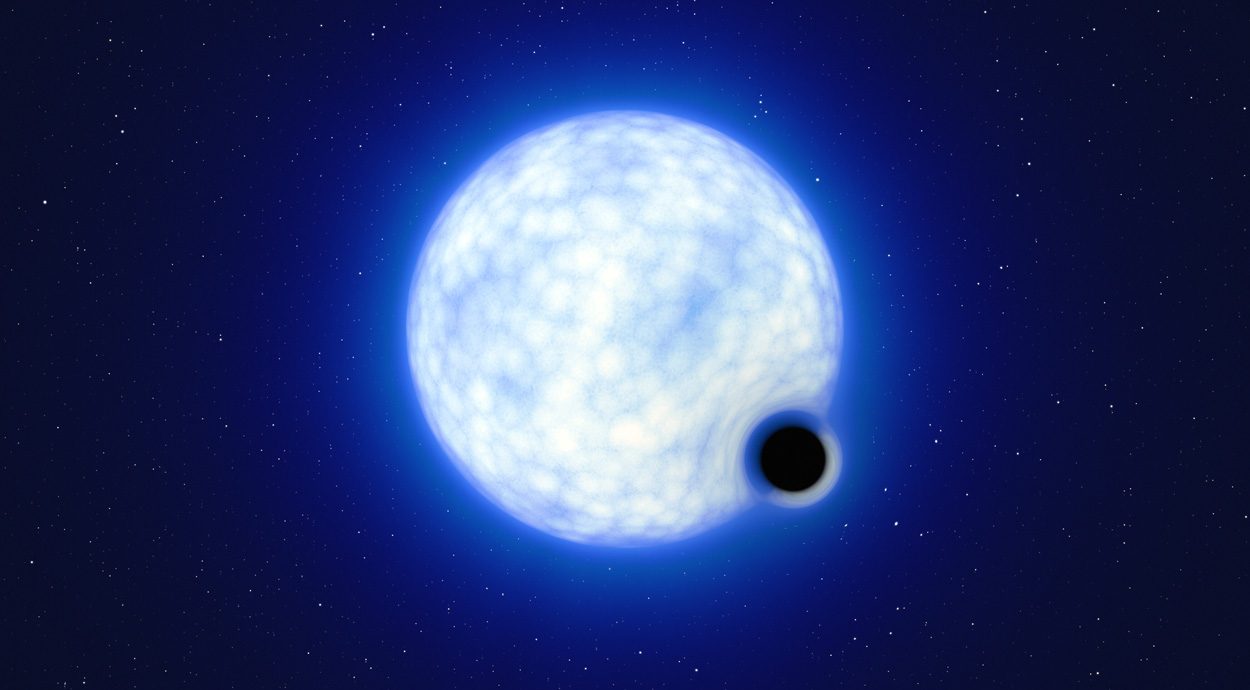There should already be millions of stellar black holes in the Milky Way – the remnants of massive stars. However, so far little is known because they are invisible and hard to find. Now astronomers may have discovered such a stellar black hole in the Large Magellanic Cloud. It was revealed by her allure on a huge and shining Shrek star. By its movements, it can be seen that the invisible partner is an inactive black hole with a mass of nine solar masses. If confirmed, it would be the first detection of such a dormant stellar black hole outside the Milky Way.
Stellar black holes form when massive stars reach the end of their life cycles and collapse under the influence of their own gravity. The fact that such black holes exist is proven, among other things, by the detection of gravitational waves that are emitted when two black holes collide and merge. But direct detection of these massive star trails is more difficult. Since they are invisible, such stellar black holes can only be observed when they absorb matter, for example from a companion star. This material then emits high-energy X-rays, revealing the presence of the black hole. However, so far only a few such binary systems consisting of an active star and a black hole are known. Such stellar black holes are difficult to detect when they are asleep and no X-rays are emitted from their vicinity.
Find invisible companions
“We’ve been searching for such black holes and binary star systems for more than two years,” says co-author Julia Bodensteiner of the European Southern Observatory (ESO) in Garching. For their study, astronomers chose the Tarantula Nebula, a region in the Large Magellanic Cloud where there are a particularly large number of massive stars and binary star systems. Using six years of observational data from ESO’s Very Large Telescope in Chile, they specifically searched for stars whose motions indicated an unseen heavy partner. Using a high-resolution FLAMES spectrometer, researchers led by first author Tomer Schnarer of the Catholic University of Leuven in Belgium were able to identify these motions based on small fluctuations in the starlight spectrum.
The team found what they were looking for in one of the stars: a hot bluish star with a mass of about 25 solar masses that is apparently part of a binary star system with a hidden partner, astronomers have identified. Both partners orbit each other with an orbital period of 10.4 days. “While the motion of the primary star is clearly visible in the spectrum, we were not able to determine the signature of the second body in the spectroscopic data,” the astronomers reported. Therefore, this partner cannot be an ordinary star or any other intensely radiating object. However, the motions of the visible star show that its partner must have a mass of at least nine solar masses – and therefore is within the range of a small stellar black hole. According to astronomers, this is also the most reasonable explanation for their observations. “We found a needle in a haystack,” says Schnarer.
An inactive black hole outside our galaxy
If confirmed, the system called VFTS 243 would not only be a new addition to the few stellar black-hole binary systems known to date — it would also be the first dormant stellar black hole discovered outside the Milky Way. “When Tomer asked me to check his results, I had my doubts. Co-author Karim El-Badri of the Center for Astrophysics | Harvard and Smithsonian in the USA says he has already flagged many of the supposed discoveries of black holes as wrong. But this time, he too Convinced, he explains.So there is no evidence that it is a different object, and at the same time the small outflow of matter from the primary star also fits into a dormant black hole as a partner.
The discovery also provides new insights into the processes by which these black holes form from massive progenitor stars. Conventional wisdom says that this happens when a dying star first expands and then its core collapses under its own weight. Typically, this core collapse leads to a supernova explosion – at least that’s the assumption. However, there is mounting evidence that some stars can collapse directly into black holes without exploding. This may be exactly the case with the recently discovered representative: “The star that formed the black hole in VFTS 243 appears to have collapsed completely, with no evidence of a previous outburst,” according to Shenard. “Recent evidence for this direct collapse scenario has been abundant, but our study provides one of the most direct evidence.”
Source: Tomer Shenar (KU Leuven) et al., Nature Astronomy, doi: 10.1038/s41550-022-01730-y

“Alcohol buff. Troublemaker. Introvert. Student. Social media lover. Web ninja. Bacon fan. Reader.”





More Stories
Up to 100 pilot whales stranded in Western Australia – Science
Huge radiation explosion from a magnetar – forschung.de
Principles and features of the folk nutritional principle